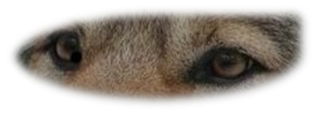Wolf
Wolf between myth and truth
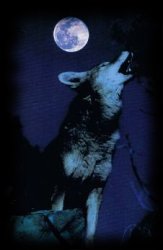
The tale of the wolf as a child murderer, arch-enemy of the people who has the power, to devour earth: is it all a lie ?
Many people have revered him and have admired, but at the same moment in time they have feared and hated him, finally from the Middle Ages, have fought him with the most brutal means.
Each of us knows tales about the wolf, in essence only bad tales. Good tales one knows only from times last for a long time, from Eskimo or Indian legends or the old Egypt. With the Eskimos and Indians the wolf was revered, although the person hunted the same preys like he; one could call wolf and person even competitors. But the hunt of the people did not reduce the prey of the wolf. It was enough there for both. So the prairie Indians named the wolf brother. Now and again they also hunted him, because they needed the wolf fur as a camouflage because the buffalos, important preys, can be hunted with it dressed much easier. From wolves buffalos usually did not have to fear anything and they let them therefore to approach very close, so close that people clothed in the fur of the wolves were able to shoot them with arrow and bow.
As mentioned in a legend of the Indians who lived in Columbia, there was a time, when the people were animals. There were the beaver-people, the deer-people, the bird's-people and many more, and there were the monsters. The animal-people were selfish and ignorantly. They were threatened by the monsters. Therefore the earth sent the wolf which taught the animal-people, to live righteous and wise. The wolf killed the monsters and created the people from their parts of the body. From the legs became members of the Klickitat-trunk who can run particularly quickly. From the arms became the Cayase-Indians who can shoot particularly well. From the trunk became the Indians who lived by the river, and so from all parts of the body trunks with special qualities have been made by the wolf. But to the Indians of the south coast the wolf in the hurry forgot to give a mouth. He made this up with a knife.
The wolf as a creator, a little bit slovenly and forgetful, but good and wise. This positive attitude opposite the wolf was typical for many societies on the level of the hunters and collectors, but also the first farmers. Only the extended attitude of pets changed the picture of the wolf also in these cultures.
In other cultural areas the wolf took already early a double role, admirable, but also as a symbol for the inexplicable, evil, fear-giving, as for example the night. It is astonishing that this ambivalence is to be found in the mythology of the west as well as in the one of the east. In India the wolf was considered as a holy animal for a long time and might be killed neither nor be offended. In the "Mahabharata", a Hindu's-epic, the wolf stands for honour, bravery and triumphant heroism.
Also in the Northern European countries, in the old-Germanic mythology as of "Edda", the wolf is a conflicting nature. Odin, also named Wotan, father of the gods and god of war at the same time, was sometimes illustrated with a wolf head and always appeared in accompany of both the wolves Gere and Freke. The wolf meant here bravery and fame. But with the bad Fenriswolf the decline came for Odin and the whole world. The bad wolf won against the property, the bravery.
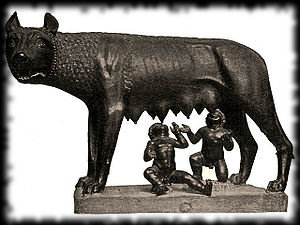
Rome owes as mentioned in the legend to a she-wolf its establishment which has nursed the founders of Rome, Remus and Romulus, saved them, and has brought them up. Also leading genders of the Turk- and Tartar's peoples derived their origin from mythological wolves. The Mongol's monarch Dschingis Khan was proud of his origin of the wolf Bört-a-Tchao which had climbed down from the sky to marry a deer princess. Also here the custom continued itself to honour the wolf, later.
In the old Egypt the wolf and also his descendant was considered as a guard of the burial places and the realm of the dead. The Egyptian city of Assiut, named Lykonpolis in Greek, is to be translated in "city of the wolves". This city was consecrated exclusively to the wolf cult. Here ruled Upuaut, the "opener of the ways", the wolf God. He protected the land against enemies and led own warriors safely in the enemy country. With the Egyptians as well as with the Teutons the connection of battle and death with the wolf embodied a special decoration. It was a matter of praising the death full of fame of the warrior or ruler and of not to representing a defenceless victim.
In the Old Testament the wolf was respected for the first time and exclusively as a symbol of the evil, as a personified Satan, confronted to the good herdsman, the servant of God. The wolf as a symbol for false doctrine and danger for person and Christianity is to be found in the New Testament innumerable times. This negative picture has contributed certainly to the fact, that the wolf and later also alleged wolf-people, the werewolves which were stigmatized and pursued by the Roman Catholic church.
In Greece of the antiquity again this wolf picture was unknown, at least in the ruling class. Here the wolf was considered as a defender of the people. In Argos one revered him as the conqueror of the bull who came to waste the land. Also Aphrodite, the goddess of the love was shown with the Greeks often in accompaniment of a wolf.
Existence-threatening conflicts with the people put still up to the acting representative of Satan on the earth, the fertility symbol, the guard of sanctuaries, the founder of cities, the furious warrior, the devourer of earth, the progenitor of ruler's dynasties. These developed themselves only in the Middle Ages. Why did it came to a such cruel and inexorable campaign against a sort which had been a symbol of the evil up to this moment, certainly, again, did never bothered people and possessed her right of existence on the earth naturally ? The principal reason may be that with increasing population density more and more forest was cleared for villages and cities and also for the cattle-keeping and putting on by meadows and fields. So the territories of the wolves shrank, as well as the ones of their preys. The wolves made a mistake in the pets. Besides, the game felt over the grasses cultivated by the people. The game flought from the people into the impassable mountains and first of all deprived itself the wolf.
Later the game was even looked after in the spell forests of the aristocrats and was maintained, because the hunt for the purpose of the food procurement gave way to the aristocracy hunt for the purpose of the joy and satisfaction of the human hunting instinct. But the wolf discovered the refuges of its prey and moved in the spell forests. With it only the wolf conflicted with the unhindered increase of the game in the spell forests which was bitter pursued by the aristocrats equipped with shot weapons. This arranged the robber to withdraw nearly completely into the rural regions. Here he threatened the farmers living in existential fear not only, while he robbed the pets, he also attacked people in hunger times, too, first of all children.
The hate of the people opposite the wolf increased gradually in the immense. He became high-stylized the devil whose single life aim was to torment the people and to damage to him. Wars and robbers had no more terrible omen than the wolf. The crucial campain of eradication against the wolf was initiated by emperor Karl der Grosse in the 8th century. He ordered that every county must occupy 2 hunters to exterminate the wolves. In May when the young wolves left the caves, these had to be hunted up by the Louvertiers and be eliminated with poison, safety hook, dogs and wolftraps. For the wolf hunt even special dog's races were bred, as the Alsatian, and new hunting methods and killing methods invented which were extremely brutal. Only among Karl VI in the 14th century the wolf hunt was regulated again and it appeared gradually a defusing of the situation.
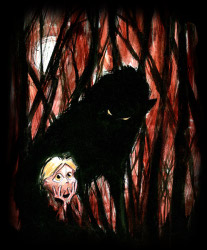
In the Middle Ages innumerable stories, fairy tales, fables, exorcisms and Rites about and also as protection against the wolf arised. Magic mottoes, consecrated wooden sticks, wolf lamps - it was supposed that the wolf avoids the light - and music were used against him. From these Rites innumerable kept till 19th century. Each knew the wolf, but nobody, really, knew somewhat about him.
Up to this moment the wolf populations had already strongly gone back in a lot of regions of Europe. The most different pictures of the wolf were drawn, some we know today that they stated rather something about the life of that time, the people and their fears and concerns, about the aspiration for power of the aristocrats or the oppression of the farmers, women and children, as about the wolf themselves.
In the fables of this time wolf and fox play an essential role. The wolf is represented here as an opponent by farmers, lumberjacks or charcoal burners. The picture, the wolf shows, is not necessarily cruel, but particularly also not positive. Frequently he is described as a fool, scaredy-cat and blockhead who falls for every craft. The fox who divided with him mostly the leading part, was represented in the fables on the contrary as sly and cunningly. Today one supposes that the wolf was a symbol for the "silly", arrogant upper class and the fox should symbolize, however, the sly enslaved middle class and lower layer. The negative picture the person of the wolf created, was fine also the revenge of the farmers for the fear which the cattle thief gave them.
From all this symbolism and pictures appeared many wolf fairy tales. In the German speech area the probably most famous is the "Red Riding Hood". This has a long previous history which was written down, finally, in the 17th century by Charles Perrault - at the negative end. The morality from this lamp holder was: woman (grandmother, granddaughter), do not trust any man (wolf) and man, do not let yourself seduce by young girls (Red Riding Hoods), and old woman, take care of the envy of the granddaughters.
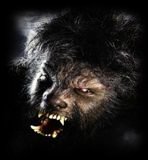
Not only in fables and fairy tales, but also in the reality, the history of the people devouring Fenriswolfs emerged in the Middle Ages in the form of the werewolf. Werewolves, people, half wolf, half person were, not only in the mythology, but also in the reality in the form of man's secret societies which can be revered in wolf fur hidden as wolf Gods and also did not shrink back from human sacrifices. Also the Teutons maintained such trainings and alliances to the mark of bravery and brutality. But these customs have never reached such sizes like in case of the werewolves of the Middle Ages. In bloody ceremonies men or children, too, who behaved themselves abnormally, carried wolf spelts, came from a family with more than seven children, which possessed erotic or melancholic radiant emittance and first of all offended against the laws of the church, became submitted to the inquisition. Up to 18th century Werewolves held the people in breath. One believed, correspondingly inclined people are in the position to change at certain times into wolves. Half person, half animal and from the devil possessed these forms at moonlit nights drove their dreadful state of affairs. They murdered children and women, drank the still warm blood of their victims, devoured the intestines and celebrated satanic orgies.
The campain of eradication which took place for centuries, paired with the cruel images about the acts of the wolf and the decline of his living space, pointed success. In England the wolf disappeared in 1743. In 1772 the last wolf was shot in Denmark. Everywhere where there was still forest and fit for hunting game for the wolf, he kept to far 19th century. In 1847 one shot in the Bavarian Forest the last wolf. At the same moment he disappeared to the north of the Alps. In 1881 the wolf was exterminated in Switzerland, in 1888 in the Eifel and in 1911 in the Alsace. In Sweden one shot between 1827 and 1839 annually approximately 500 wolves, twenty years later they had disappeared in south Sweden.
In North America the eradication of the wolf ran in a completely different way. Because the wild existence was decimated in a lot of regions too much and becaus it still gave suitable retreat areas, here the wolves were chased away only from the regions taken possession by white settlers. When the settlers also started hunting on herds of buffalo, the wolves, which libed in a certain symbiosis with the buffalos disappeared immediately. The "Wolfers" laid out poisoned buffalo's meat and could draw off the fur already next day off the rigidly frozen, poisoned wolves. Finally, from the bright maned buffalo's wolves not a single one stayed alive. These and many other subspecies became extinct.
DNow the question is how dangerously a wolf really is ? Did human kind hunt him as food competitors or because he needed his warming fur, or did he hunt becaus of hate and fear of his life ? What did justify that the person executed this retaliation campaign against a sort ? Of course the wolf in the Middle Ages arranged big economic damage in decimating the herd of the small farmer, but whether he has ever really attacked people, however, is controversial. It is interesting that in North America such infringements are denied in the whole history. An American journalist put out a reward of 1 ' 000 dollars approximately 50 years ago if somebody could produce the proof to him that ever a healthy, freely living wolf has attacked people. To this day the price still is to be had with interest and compound interests.
Are the wolves better than their call, and the European person has himself let carry away from the extrasensory, from poems and mythology ? A lot speaks for it. It is known that in Europe big dog's races were bred to the fight by wolves. However, many of these dogs freely might stray and so it came to crossings between wolves and dogs who were a lot more large and more aggressive than wolves and had in addition less fear of the people. The indications that dogs were the beasts, which killed the people, there are some. For example, the fur of both beasts was described by Gévaudin as a mixture from chocolate-coloured and red-brown. But such a fur colouring is not found with the European wolf. Likely it was about half-bloods from mastiffs and wolves.
Also to this day is reported by attacks of wolves on people - it might be nurse's fairy tales. It is sure that wolves have attacked actually people, at a time, however, when the wolf populations were still bigger. However, the attacked people died mostly of rabies and not in the added violations. It also votes that wolves ate people, for example, after or during long wars in hunger times.
To this day neither the cultivation of dog's races glorifying him is useful to the wolf, nor the omen of the biologists that he belongs to the strongest wild animals most able to survive. Even if he can camouflage himself still so well and adapt, he has no chance in our western man-made landscape with road system, travelling routes and hunter's stands. Will be the person able to offer him an appropriate place ? Only we can do it with information, dismantling of old fears and prejudices and the knowledge about the right of existence of all living beings to ourselves giving a new picture to the former beast. But till there the way is still long, because also the modern fairy tales have not internalized the new desirable image of the wolf yet.
© Alaskan-Malamute.ch

